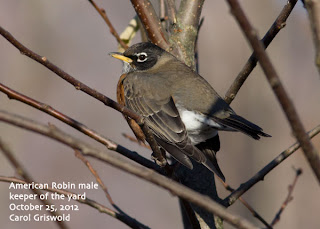Seward,
Alaska Sporadic Bird Report
Sunrise
9:17 am, sunset 6:01 pm, length of day 8 hours, 41 minutes; tomorrow will be 5
minutes and 11 seconds shorter.
Weather:
Brrr! The NNW wind abated a bit from yesterday, down to 10-15 mph with gusts to
26 mph. Combined with temperatures in the mid-20s, the windchill diped to -9º F. Featureless gray clouds hold a
promise of snow, but the frozen ground remains mostly bare. The abundant Mt Ash
berry crop waits expectantly for all fruit-loving birds.
Unleaded
gas is $4.58/gallon.
Today,
the Alaska Sealife Center released two SMEWS into the main bird habitat. They
shot out of the small animal crate and briefly flew around before landing in
the water. This novelty created quite a buzz for the resident birds. The COMMON
MURRES and PIGEON GUILLEMOTS seemed most upset with the intruders and chased
them around. Hopefully, the young male and older female will be accepted into
the flock soon and peace will return.
The
Smews were obtained from a breeder, not from the wild. This Eurasian species is
a rare visitor to Alaska in the Aleutians and Pribilofs. Like the Red-legged
Kittiwakes on display, this is a wonderful opportunity for birders to observe
them through the seasons. Both are now gray birds with chestnut foreheads and
crowns. Soon the male will mature into the classic stunning "cracked
ice" white and black plumage. The ASLC offers free admission to Alaskans
on Wednesdays from November through February, open 10-5 daily, closed on TDay
and Christmas.
I
saw a couple dozen beautiful BARROW'S GOLDENEYES in the choppy waters near the
Founder's Monument as I left the ASLC. Next, I visited Lowell Point to swim the
good dog (who has no problem with freezing temperatures or wind chill). It was
nice to see a STELLER'S SEA LION in the wild, poking its nosy-nose out of the
water, observing us with curiosity. HARLEQUINS swam and dove in pairs off shore
and along the road.
Peregrine
Joe reported 2 RUSTY BLACKBIRDS at the horse corral by the Lagoon. I found one
when it flew to the top of a cone-laden spruce tree. It did not eat or linger, and
quickly flew back down to the ground under the willows.
An
adult BALD EAGLE standing on the ice of the Lagoon with a salmon carcass grew
tired of the 3 MAGPIES and GLAUCOUS-WINGED GULL that hounded it for scraps.
Snatching up the carcass, it flew off to a tree snag for a few moments of
peace.
Joe
also found a YELLOW-BILLED LOON.
Ava
reported the BOHEMIAN WAXWING returned today after a few days' absence,
rejoining the juvenile CEDAR WAXWING and ROBIN.
Robin
C reported 4 GREAT BLUE HERONS at the beach on Monday.
Happy
Birding!
Carol
Griswold
Seward
Sporadic Bird Report Reporter
PS I learned today that the swan that was recently rescued in
Seward is a TUNDRA SWAN. She will be released in a week or so in a Washington
refuge where she will join last year's rescued swan, Marshmallow, who suffered
from an arrow injury at Tern Lake. If all goes well, the Tundra Swan's foot
will heal, and she will be able to rejoin her family when they migrate north in
the spring.
Her caregiver, Tasha, said the lonely swan would not eat
initially and seemed despondent until she put a mirror in the enclosure and
played Tundra Swan calls.
Those brilliant but simple tricks worked and now her prognosis
looks very good.
Thanks, Tasha and the ASLC!



















































